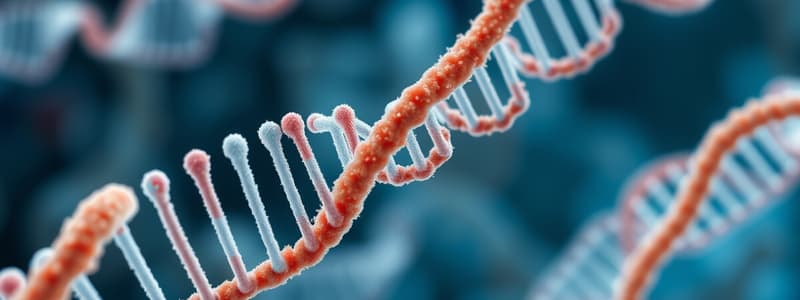Podcast
Questions and Answers
What is the primary role of tRNA in protein synthesis?
What is the primary role of tRNA in protein synthesis?
- To decode the mRNA sequence into amino acids
- To carry genetic information from DNA to ribosomes
- To form peptide bonds between amino acids
- To transport the necessary amino acids to the ribosome (correct)
Which component of the ribosome primarily interacts with mRNA during translation?
Which component of the ribosome primarily interacts with mRNA during translation?
- Exit tunnel of the large ribosomal subunit
- Aminoacyl-tRNA site
- Peptidyl transferase center
- Small ribosomal subunit (correct)
What happens to tRNA after it has added its amino acid to the growing protein chain?
What happens to tRNA after it has added its amino acid to the growing protein chain?
- It undergoes post-translational modification
- It reenters the cytoplasmic pool to be recharged (correct)
- It directly binds to mRNA to signal termination
- It is destroyed and cannot be reused
Which part of the ribosome is predominantly responsible for forming peptide bonds?
Which part of the ribosome is predominantly responsible for forming peptide bonds?
In the context of protein synthesis, what is the significance of codons?
In the context of protein synthesis, what is the significance of codons?
What function does tRNA serve in the process of translation?
What function does tRNA serve in the process of translation?
Which statement accurately describes the ribosome structure involved in protein synthesis?
Which statement accurately describes the ribosome structure involved in protein synthesis?
How is the correct amino acid attached to its respective tRNA?
How is the correct amino acid attached to its respective tRNA?
What role does mRNA play in the process of translation?
What role does mRNA play in the process of translation?
What is the primary determinant for a tRNA molecule to recognize and bind to an mRNA codon?
What is the primary determinant for a tRNA molecule to recognize and bind to an mRNA codon?
Flashcards are hidden until you start studying
Study Notes
Overview of Protein Synthesis
- Protein synthesis involves the translation of mRNA into a polypeptide chain.
- mRNA exits the nucleus through nuclear pores and attaches to ribosomes in the cytoplasm.
Role of tRNA
- Each type of tRNA carries a specific amino acid, catalyzed by an enzyme called aminoacyl-tRNA synthetase.
- tRNA has an anticodon that recognizes and binds to a complementary mRNA codon.
Translation Process
- Incoming tRNA binds to the appropriate codon on the mRNA, facilitating the addition of a new amino acid to the growing protein chain.
- Ribosomes consist of a large and small subunit, with the small subunit reading the mRNA.
Peptide Bond Formation
- The addition of an amino acid occurs through peptide bond formation between the amino acids in the ribosome.
- As the ribosome advances, the mRNA strand is read sequentially, enabling continuous polypeptide elongation.
tRNA Recycling
- Once the amino acid is contributed, the tRNA is released and reenters the cytoplasm, ready to be charged with a new amino acid.
Key Steps in Translation
- Step 4: Ribosome progression along the mRNA leads to the incorporation of new amino acids.
- Step 5: Released tRNA returns to the cytoplasmic pool for recharging.
Studying That Suits You
Use AI to generate personalized quizzes and flashcards to suit your learning preferences.




